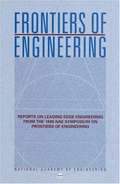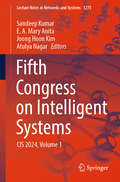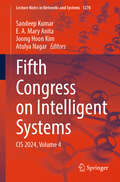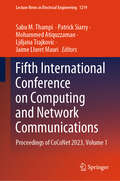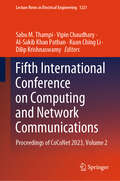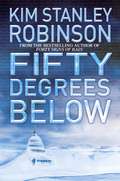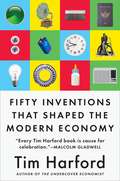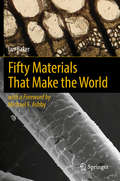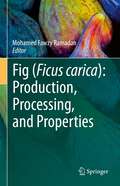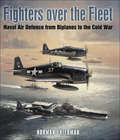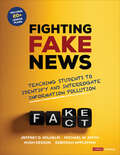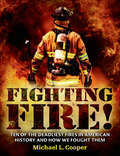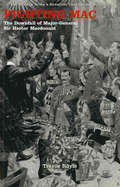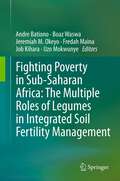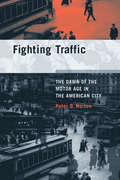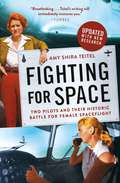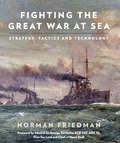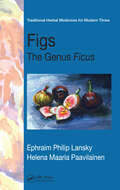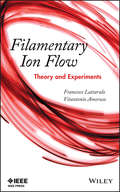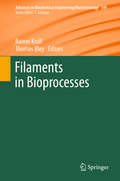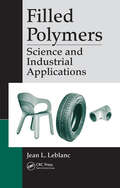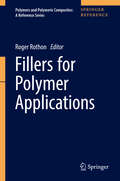- Table View
- List View
Fifth Annual Symposium on Frontiers of Engineering: National Academy of Engineering
by National Academy of EngineeringThe National Academies Press (NAP)--publisher for the National Academies--publishes more than 200 books a year offering the most authoritative views, definitive information, and groundbreaking recommendations on a wide range of topics in science, engineering, and health. Our books are unique in that they are authored by the nation's leading experts in every scientific field.
Fifth Congress on Intelligent Systems: CIS 2024, Volume 1 (Lecture Notes in Networks and Systems #1275)
by Sandeep Kumar Atulya Nagar Joong Hoon Kim E. A. Mary AnitaThis book is a collection of selected papers presented at the Fifth Congress on Intelligent Systems (CIS 2024), organized by CHRIST (Deemed to be University), Bangalore, India, under the technical sponsorship of the Soft Computing Research Society, India, during September 4–5, 2024. The book covers high-quality research articles in the fields of soft computing, machine vision, robotics, computational intelligence, artificial intelligence, signal and image processing, data science techniques, and their real-world applications which are some of the recent advancements in the real-world technologies.
Fifth Congress on Intelligent Systems: CIS 2024, Volume 4 (Lecture Notes in Networks and Systems #1278)
by Sandeep Kumar Atulya Nagar Joong Hoon Kim E. A. Mary AnitaThis book is a collection of selected papers presented at the Fifth Congress on Intelligent Systems (CIS 2024), organized by CHRIST (Deemed to be University), Bangalore, India, under the technical sponsorship of the Soft Computing Research Society, India, during September 4–5, 2024. The book covers high-quality research articles in the fields of soft computing, machine vision, robotics, computational intelligence, artificial intelligence, signal and image processing, data science techniques, and their real-world applications which are some of the recent advancements in the real-world technologies.
Fifth International Conference on Computing and Network Communications: Proceedings of CoCoNet 2023, Volume 1 (Lecture Notes in Electrical Engineering #1219)
by Patrick Siarry Sabu M. Thampi Mohammed Atiquzzaman Ljiljana Trajkovic Jaime Lloret MauriThis book constitutes thoroughly refereed post-conference proceedings of the 5th International Conference on Computing and Network Communications, CoCoNet'23. The revised papers presented are carefully reviewed and selected from several initial submissions. The scope of the Symposium includes Network-on-Chip Architectures and Applications, Future Internet Architecture and Protocols, Intelligent Networked Systems, IoT and smart cities, Communications Systems Integration and Modelling, and Wireless and Mobile Communications. The book is directed to the researchers and scientists engaged in various fields of network communications.
Fifth International Conference on Computing and Network Communications: Proceedings of CoCoNet 2023, Volume 2 (Lecture Notes in Electrical Engineering #1221)
by Sabu M. Thampi Al-Sakib Khan Pathan Vipin Chaudhary Dilip Krishnaswamy Kuan Ching LiThis book constitutes thoroughly refereed post-conference proceedings of the 5th International Conference on Computing and Network Communications, CoCoNet'23.The revised papers presented are carefully reviewed and selected from several initial submissions. The scope of the Symposium includes network-on-chip architectures and applications, future internet architecture and protocols, intelligent networked systems, IoT and smart cities, communications systems integration and modeling, and wireless and mobile communications. The book is directed to researchers and scientists engaged in network communications.
Fifty Degrees Below (Capital Code #2)
by Kim Stanley RobinsonBestselling, award-winning, author Kim Stanley Robinson continues his groundbreaking trilogy of eco-thrillers-and propels us deeper into the awesome whirlwind of climatic change. <P><P>Set in our nation's capital, here is a chillingly realistic tale of people caught in the collision of science, technology, and the consequences of global warming-which could trigger another phenomenon: abrupt climate change, resulting in temperatures. . . <P><P>When the storm got bad, scientist Frank Vanderwal was at work, formaliz...
Fifty Inventions That Shaped the Modern Economy
by Tim HarfordA lively history seen through the fifty inventions that shaped it most profoundly, by the bestselling author of The Undercover Economist and Messy. Who thought up paper money? What was the secret element that made the Gutenberg printing press possible? And what is the connection between The Da Vinci Code and the collapse of Lehman Brothers? Fifty Inventions That Shaped the Modern Economy paints an epic picture of change in an intimate way by telling the stories of the tools, people, and ideas that had far-reaching consequences for all of us. From the plough to artificial intelligence, from Gillette’s disposable razor to IKEA’s Billy bookcase, bestselling author and Financial Times columnist Tim Harford recounts each invention’s own curious, surprising, and memorable story. Invention by invention, Harford reflects on how we got here and where we might go next. He lays bare often unexpected connections: how the bar code undermined family corner stores, and why the gramophone widened inequality. In the process, he introduces characters who developed some of these inventions, profited from them, and were ruined by them, as he traces the principles that helped explain their transformative effects. The result is a wise and witty book of history, economics, and biography.
Fifty Materials That Make the World
by Ian BakerThis book introduces materials and how advances in materials result in advances in technology and our daily lives. Each chapter covers a particular material, how the material was discovered or invented, when it was first used, how this material has impacted the world, what makes the material important, how it is used today, and future applications. The list of materials covered in this book includes stone, wood, natural fibers, metals, clay, lead, iron, steel, silicon, glass, rubber, composites, polyethylene, rare earth magnet, and alloys.
Fig (Food Bioactive Ingredients Ser.)
by Mohamed Fawzy RamadanThis book creates a multidisciplinary forum of discussion on Ficus carica with particular emphasis on its horticulture, post-harvest, marketability, phytochemistry, extraction protocols, biochemistry, nutritional value, functionality, health-promoting properties, ethnomedicinal applications, technology and processing. The impact of traditional and innovative processing on the recovery of high-added value compounds from Ficus carica byproducts is extensively reported. Also, the text discusses the potential applications of Ficus carica in food, cosmetics, and pharmaceutical products. Fig (Ficus carica): Production, Processing, and Properties illustrates a diversity of developments in food science and horticultural research including:Production, processing, chemistry, and functional properties of Ficus carica.Ficus carica phytochemicals and its health-promoting effects.Food, non-food and technological applications of Ficus carica.Recent research focuses on studying the bioactive compounds and therapeutic traits and investigating the mode of action and toxicological impacts of medical plant extracts and bioactive phytochemicals. Ficus carica is of significant importance due to its widespread food, industrial and medicinal applications. Although Ficus carica products are already commercially available in the international market, it is hard to find a reference work covering the production, processing, chemistry and properties of Ficus carica. This book will be the first publication focusing specifically on this important topic.
Fighters Over the Fleet: Naval Air Defence from Biplanes to the Cold War
by Norman FriedmanA tactical and technical history of the development of British, American, and Japanese naval air defense from the 1920s to the 1980s. This is an account of the evolution of naval fighters for fleet air defense and the parallel evolution of the ships operating and controlling them, concentrating on the three main exponents of carrier warfare: the British Royal Navy, the U.S. Navy, and the Imperial Japanese Navy. It describes the earliest efforts from the 1920s, but it was not until radar allowed the direction of fighters that organized air defense became possible. Thus, major naval-air battles of the Second World War like Midway, the Pedestal convoy, the Philippine Sea, and Okinawa are portrayed as tests of the new technology. This was ultimately found wanting by the Kamikaze campaigns, leading to postwar moves towards computer control and new kinds of fighters. After 1945 the threats of nuclear weapons and standoff missiles compounded the difficulties of naval air defense. The second half of the book covers R.N. and U.S.N. attempts to solve these problems, looking at the American experience in Vietnam and British operations in the Falklands War. It concludes with the ultimate U.S. development of techniques and technology to fight the Outer Air Battle in the 1980s, which in turn point to the current state of carrier fighters and the supporting technology. Based largely on documentary sources, some previously unused, this book will appeal to both the naval and aviation communities.&“Fighters Over the Fleet provides more information about fleet air defense than any other work currently available. It is recommended for specialist as well aviation-minded readers.&” —Naval Historical Foundation
Fighting Campylobacter Infections: Towards a One Health Approach (Current Topics in Microbiology and Immunology #431)
by Steffen BackertThis edited volume explores Campylobacter species, which are some of the most important foodborne pathogens. Above all, contaminated poultry meat can cause human gastroenteritis in both developed and developing countries. The respective contributions reveal how these infections can also increase the risk of generalized paralytic diseases such as Guillain-Barré syndrome, Miller-Fisher syndrome, and Chinese paralytic syndrome. Due to their influence on the nervous system, circulatory system, and various organs, Campylobacter infections represent a serious public health concern.Campylobacter can be effectively combated by addressing the hygienic conditions in both food production and human lifestyles. Accordingly, the authors put forward a One Health perspective, which provides readers with essential insights into the basic biology of Campylobacter, as well as practical guidance on aspects ranging from food production to the clinical treatment of infections.Chapter 'Natural Competence and Horizontal Gene Transfer in Campylobacter’ is available open access under a Creative Commons Attribution 4.0 International License via link.springer.com.
Fighting Fake News: Teaching Students to Identify and Interrogate Information Pollution (Corwin Literacy)
by Michael W. Smith Jeffrey D. Wilhelm Deborah Appleman Hugh KessonCritical thinking and online reading need to go hand in hand—but they often don’t. Students click, swipe, and believe because they don’t know how to do otherwise. At times, so do we. And that’s a problem. Fighting Fake News combats this challenge by helping you model how to read, myth-bust, truth-test, and respond in ways that lead to wisdom rather than reactivity. No matter what content you teach, the lessons showcased here provide engaging, collaborative reading and discussion experiences so students can: Notice how teacher and peers read digital content, to be mindful of how various reading pathways influence perception Identify the author background, the website sponsor, and other evidence that help set a piece in context Stress-test the facts by evaluating news sources, reading laterally, and other critical reading strategies Use "Reader’s Rules of Notice" to learn to identify common rhetorical devices used to influence the reader Be aware of how for-profit social media platforms feed on our responses to narrow rather than widen our reading landscape We are still in the wild west era of the digital age, scrambling to impart a safer, ethical framework for evaluating information. Thankfully, it distills to one mission: teach students (and ourselves) how to think critically, and we will forever have the tools to fight fake news.
Fighting Fake News: Teaching Students to Identify and Interrogate Information Pollution (Corwin Literacy)
by Michael W. Smith Jeffrey D. Wilhelm Deborah Appleman Hugh KessonCritical thinking and online reading need to go hand in hand—but they often don’t. Students click, swipe, and believe because they don’t know how to do otherwise. At times, so do we. And that’s a problem. Fighting Fake News combats this challenge by helping you model how to read, myth-bust, truth-test, and respond in ways that lead to wisdom rather than reactivity. No matter what content you teach, the lessons showcased here provide engaging, collaborative reading and discussion experiences so students can: Notice how teacher and peers read digital content, to be mindful of how various reading pathways influence perception Identify the author background, the website sponsor, and other evidence that help set a piece in context Stress-test the facts by evaluating news sources, reading laterally, and other critical reading strategies Use "Reader’s Rules of Notice" to learn to identify common rhetorical devices used to influence the reader Be aware of how for-profit social media platforms feed on our responses to narrow rather than widen our reading landscape We are still in the wild west era of the digital age, scrambling to impart a safer, ethical framework for evaluating information. Thankfully, it distills to one mission: teach students (and ourselves) how to think critically, and we will forever have the tools to fight fake news.
Fighting Fire!: Ten of the Deadliest Fires in American History and How We Fought Them
by Michael L. CooperFrom colonial times to the modern day, two things have remained constant in American history: the destructive power of fires and the bravery of those who fight them.Fighting Fire! brings to life ten of the deadliest infernos this nation has ever endured: the great fires of Boston, New York, Chicago, Baltimore, and San Francisco, the disasters of the Triangle Shirtwaist Factory, the General Slocum, and the Cocoanut Grove nightclub, the wildfire of Witch Creek in San Diego County, and the catastrophe of 9/11. Each blaze led to new firefighting techniques and technologies, yet the struggle against fires continues to this day. With historical images and a fast-paced text, this is both an exciting look at firefighting history and a celebration of the human spirit.
Fighting Mac: The Downfall of Major-General Sir Hector Macdonald
by Trevor RoyleOn a spring morning in 1903, Major-General Sir Hector Macdonald, one of Britain's greatest military heroes, took his life in a hotel room in Paris. A few days later he was buried hastily in an Edinburgh cemetary as his fellow countrymen tried to come to terms with the fact that one of Scotland's most famous soldiers had ended his life rather than face charges against his character.The suicide and its aftermath created a national scandal and one which still reverberates long after those dramatic events - it is now clear that the official files dealing with his case, the papers of the Judge Advocate have been destroyed. Macdonald or 'Fighting Mac' as he was known to an adoring public, was no ordinary soldier. A crofter's son who had risen from the ranks in the Victorian army, he covered himself with glory during a long and successful military career and in 1898 was widely acknowledged as the true hero of the Battle of Omdurman, which cemented British Imperial rule in Anglo-Egyptian Sudan. Everything lay at his feet - a knighthood, honours, the respect of fellow generals such as Roberts and Kitchener - but Macdonald's career came to a shocking full stop when he stood accused of homosexuality and was ordered to face a court martial. Unable to come to terms with the disgrace, he committed suicide. That should have been the end of his story but so powerful was the myth created by Fighting Mac that people refused to believe he was dead. Soon rumours were circulating that Macdonald had faked his death and had adopted the persona of a prominent Prussian officer, the future Field Marshal August con Mackensen, one of Germany's great leaders during the First World War. FIGHTING MAC tells the true story behind his disgrace and sheds new light on the myths....
Fighting Poverty in Sub-Saharan Africa: The Multiple Roles of Legumes in Integrated Soil Fertility Management
by Andre Bationo Boaz Waswa Jeremiah M. Okeyo Fredah Maina Job Kihara Uzo MokwunyeLegumes play an important role in the cropping systems of sub Saharan Africa (SSA). Legumes are an important source of nutrition to both humans and livestock by providing the much needed protein, minerals, fibre and vitamins. The sale of legumes seed, leaves and fibre generates income for the marginalized communities especially women. Cultivation of legumes is essential for the regeneration of nutrient-deficient soils. By biologically fixing nitrogen (BNF) in the soil, legumes provide a relatively low-cost method of replacing otherwise expensive inorganic nitrogen in the soil. This enhances soil fertility and boosts subsequent cereal crop yields. Production of legumes in SSA is however; hampered by a number of constraints among them low and declining soil fertility, low soil pH, high salinity, drought and flooding, poor access to improved germplasm, diseases, pests and weeds. Farmers need to learn how to overcome these constraints if the full benefits of legumes are to be gained. This book presents a synthesis of research work on legumes and draws attention to the importance of legumes in integrated soil fertility management (ISFM) and poverty alleviation in SSA.
Fighting Traffic: The Dawn of the Motor Age in the American City (Inside Technology)
by Peter D. NortonThe fight for the future of the city street between pedestrians, street railways, and promoters of the automobile between 1915 and 1930.Before the advent of the automobile, users of city streets were diverse and included children at play and pedestrians at large. By 1930, most streets were primarily a motor thoroughfares where children did not belong and where pedestrians were condemned as “jaywalkers.” In Fighting Traffic, Peter Norton argues that to accommodate automobiles, the American city required not only a physical change but also a social one: before the city could be reconstructed for the sake of motorists, its streets had to be socially reconstructed as places where motorists belonged. It was not an evolution, he writes, but a bloody and sometimes violent revolution. Norton describes how street users struggled to define and redefine what streets were for. He examines developments in the crucial transitional years from the 1910s to the 1930s, uncovering a broad anti-automobile campaign that reviled motorists as “road hogs” or “speed demons” and cars as “juggernauts” or “death cars.” He considers the perspectives of all users—pedestrians, police (who had to become “traffic cops”), street railways, downtown businesses, traffic engineers (who often saw cars as the problem, not the solution), and automobile promoters. He finds that pedestrians and parents campaigned in moral terms, fighting for “justice.” Cities and downtown businesses tried to regulate traffic in the name of “efficiency.” Automotive interest groups, meanwhile, legitimized their claim to the streets by invoking “freedom”—a rhetorical stance of particular power in the United States. Fighting Traffic offers a new look at both the origins of the automotive city in America and how social groups shape technological change.
Fighting for Space: Two Pilots and Their Historic Battle for Female Spaceflight
by Amy TeitelSpaceflight historian Amy Shira Teitel tells the riveting story of the female pilots who each dreamed of being the first American woman in space. When the space age dawned in the late 1950s, Jackie Cochran held more propeller and jet flying records than any pilot of the twentieth century-man or woman. She had led the Women's Auxiliary Service Pilots during the Second World War, was the first woman to break the sound barrier, ran her own luxury cosmetics company, and counted multiple presidents among her personal friends. She was more qualified than any woman in the world to make the leap from atmosphere to orbit. Yet it was Jerrie Cobb, twenty-five years Jackie's junior and a record-holding pilot in her own right, who finagled her way into taking the same medical tests as the Mercury astronauts. The prospect of flying in space quickly became her obsession. While the American and international media spun the shocking story of a "woman astronaut" program, Jackie and Jerrie struggled to gain control of the narrative, each hoping to turn the rumored program into their own ideal reality-an issue that ultimately went all the way to Congress. This dual biography of audacious trailblazers Jackie Cochran and Jerrie Cobb presents these fascinating and fearless women in all their glory and grit, using their stories as guides through the shifting social, political, and technical landscape of the time.
Fighting the Great War at Sea: Strategy, Tactic and Technology
by Norman FriedmanWinner of the John Lyman Book Award for Naval and Maritime Science and Technology. &“A compelling and convincing historical analysis of World War I.&” —Navy News While the overriding image of the First World War is of the bloody stalemate on the western front, the overall shape of the war arose out of its maritime character. It was essentially a struggle about access to worldwide resources, most clearly seen in Germany&’s desperate attempts to counter the American industrial threat, which ultimately drew the United States into the war. This radical new book concentrates on the way in which each side tried to use or deny the sea to the other, and in so doing, describes rapid wartime changes not only in ship and weapons technology but also in the way naval warfare was envisaged and fought. Melding strategic, technical, and tactical aspects, Friedman approaches the First World War from a fresh perspective and demonstrates how its perceived lessons dominated the way navies prepared for the Second World War. &“Friedman is a master of the evolution of naval strategy, tactics and technology . . . a rewarding read that will leave many wanting to return again and again just to see what they might have missed the first time.&” —Australian Naval Institute &“Dr. Friedman&’s research credentials are impeccable, and the huge amount of factual detail he has unearthed will be sure to delight many . . . there is nothing comparable in either depth or scope out there, and for this reason, if no other, this book is likely to become a standard work on the naval aspects of the Great War.&” —Naval War College Review
Figs: The Genus Ficus (Traditional Herbal Medicines for Modern Times)
by Helena Maaria Paavilainen Ephraim Philip LanskyWith a history as ancient as any cultivated fruit, many believe the fig has been with us even longer than the pomegranate. The Ficus constitutes one of the largest and hardiest genera of flowering plants featuring as many as 750 species. Although the extraordinary mutualism between figs and their pollinating wasps has received much attention, the p
Filamentary Ion Flow: Theory and Experiments
by Vitantonio Amoruso Francesco LattaruloPresents all-new laboratory-tested theory for calculating more accurate ionized electric fields to aid in designing high-voltage devices and its components Understanding and accurately calculating corona originated electric fields are important issues for scientists who are involved in electromagnetic and electrostatic studies. High-voltage dc lines and equipment, in particular, can generate ion flows that can give rise to environmental inconveniences. Filamentary Ion Flow: Theory and Experiments provides interdisciplinary theoretical arguments to attain a final model for computational electrostatics in the presence of flowing space charge. Based on years of extensive lab tests pertaining to the physical performance of unipolar corona ion flows, the book covers the enlarging of conventional electrostatic applications, which allows for some emerging and uncharted interests to be explored. Filamentary Ion Flow: Examines the theoretical discussions for creating a model of computational electrostatics involved with flowing space charges Presents new theory and experimental data based on extensive testing Offers potential design applications utilizing the theory Helps scientists who are involved in electromagnetic and electrostatic studies understand and accurately calculate corona originated ion flow fields Filamentary Ion Flow: Theory and Experiments is ideal for electrical engineers and research scientists interested in high-voltage technology, computational electrostatics, and electromagnetic theory.
Filaments in Bioprocesses
by Rainer Krull Thomas BleyThis book review series presents current trends in modern biotechnology. The aim is to cover all aspects of this interdisciplinary technology where knowledge, methods and expertise are required from chemistry, biochemistry, microbiology, genetics, chemical engineering and computer science. Volumes are organized topically and provide a comprehensive discussion of developments in the respective field over the past 3-5 years. The series also discusses new discoveries and applications. Special volumes are dedicated to selected topics which focus on new biotechnological products and new processes for their synthesis and purification. In general, special volumes are edited by well-known guest editors. The series editor and publisher will however always be pleased to receive suggestions and supplementary information. Manuscripts are accepted in English.
Filing Patents Online: A Professional Guide
by Sarfaraz K. NiaziThe average cost of an uncomplicated patent application filing is about $10,000. This high cost can leave thousands of inventors out in the cold. Filing Patents Online: A Professional Guide is a complete manual that walks inventors through each step of filing and prosecuting the patent online at a fraction of the cost. The online filing system reco
Filled Polymers: Science and Industrial Applications
by Jean L. LeblancThe idea of mixing single available materials into compounds to fulfill a set of desired properties is likely as old as mankind. Highly sophisticated polymer applications would simply be impossible without the enhancement of some of their properties through addition of fine mineral particles or synthetic or natural short fibers. Many filled polymer
Fillers for Polymer Applications
by Roger RothonThis handbook provides an introduction to and reference information about the science behind the production and use of particulate fillers in polymer applications. Fillers play an important role and are used with practically all types of polymers: thermoplastics, thermosets, elastomers. Readers will find an introduction to the topic of particulate fillers for polymer applications and their importance. The first chapters describe the use and characteristics of fillers in different polymer types, such as thermoplastics, thermosets and elastomers. The following chapters compile and summarize comprehensive information about different filler materials which find application nowadays, including mineral fillers (for example feldspars, wollastonites, and many more) and inorganic fillers (barium sulphate, or clays), bio-fillers, recycled and sustainable fillers, and fillers for specific applications (for example flame-retardant fillers, fillers for electrically conductive applications, or thermally conductive additives). Offering key information, compiled by a mixed team of authors from academia and industry, this handbook will appeal to researchers and professionals working on and with particulate polymer fillers alike.
